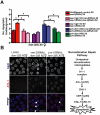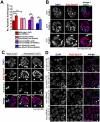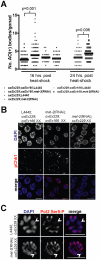Caenorhabditis elegans histone methyltransferase MET-2 shields the male X chromosome from checkpoint machinery and mediates meiotic sex chromosome inactivation
- PMID: 21909284
- PMCID: PMC3164706
- DOI: 10.1371/journal.pgen.1002267
Caenorhabditis elegans histone methyltransferase MET-2 shields the male X chromosome from checkpoint machinery and mediates meiotic sex chromosome inactivation
Abstract
Meiosis is a specialized form of cellular division that results in the precise halving of the genome to produce gametes for sexual reproduction. Checkpoints function during meiosis to detect errors and subsequently to activate a signaling cascade that prevents the formation of aneuploid gametes. Indeed, asynapsis of a homologous chromosome pair elicits a checkpoint response that can in turn trigger germline apoptosis. In a heterogametic germ line, however, sex chromosomes proceed through meiosis with unsynapsed regions and are not recognized by checkpoint machinery. We conducted a directed RNAi screen in Caenorhabditis elegans to identify regulatory factors that prevent recognition of heteromorphic sex chromosomes as unpaired and uncovered a role for the SET domain histone H3 lysine 9 histone methyltransferase (HMTase) MET-2 and two additional HMTases in shielding the male X from checkpoint machinery. We found that MET-2 also mediates the transcriptional silencing program of meiotic sex chromosome inactivation (MSCI) but not meiotic silencing of unsynapsed chromatin (MSUC), suggesting that these processes are distinct. Further, MSCI and checkpoint shielding can be uncoupled, as double-strand breaks targeted to an unpaired, transcriptionally silenced extra-chromosomal array induce checkpoint activation in germ lines depleted for met-2. In summary, our data uncover a mechanism by which repressive chromatin architecture enables checkpoint proteins to distinguish between the partnerless male X chromosome and asynapsed chromosomes thereby shielding the lone X from inappropriate activation of an apoptotic program.
Conflict of interest statement
The authors have declared that no competing interests exist.
Figures







Similar articles
-
Histone methyltransferases MES-4 and MET-1 promote meiotic checkpoint activation in Caenorhabditis elegans.PLoS Genet. 2012;8(11):e1003089. doi: 10.1371/journal.pgen.1003089. Epub 2012 Nov 15. PLoS Genet. 2012. PMID: 23166523 Free PMC article.
-
Meiotic recombination and the crossover assurance checkpoint in Caenorhabditis elegans.Semin Cell Dev Biol. 2016 Jun;54:106-16. doi: 10.1016/j.semcdb.2016.03.014. Epub 2016 Mar 21. Semin Cell Dev Biol. 2016. PMID: 27013114 Free PMC article. Review.
-
Plasticity in the Meiotic Epigenetic Landscape of Sex Chromosomes in Caenorhabditis Species.Genetics. 2016 Aug;203(4):1641-58. doi: 10.1534/genetics.116.191130. Epub 2016 Jun 8. Genetics. 2016. PMID: 27280692 Free PMC article.
-
MES-4: an autosome-associated histone methyltransferase that participates in silencing the X chromosomes in the C. elegans germ line.Development. 2006 Oct;133(19):3907-17. doi: 10.1242/dev.02584. Development. 2006. PMID: 16968818 Free PMC article.
-
Meiotic silencing in Caenorhabditis elegans.Int Rev Cell Mol Biol. 2010;282:91-134. doi: 10.1016/S1937-6448(10)82002-7. Epub 2010 Jun 18. Int Rev Cell Mol Biol. 2010. PMID: 20630467 Review.
Cited by
-
Histone methyltransferases MES-4 and MET-1 promote meiotic checkpoint activation in Caenorhabditis elegans.PLoS Genet. 2012;8(11):e1003089. doi: 10.1371/journal.pgen.1003089. Epub 2012 Nov 15. PLoS Genet. 2012. PMID: 23166523 Free PMC article.
-
Establishment of H3K9-methylated heterochromatin and its functions in tissue differentiation and maintenance.Nat Rev Mol Cell Biol. 2022 Sep;23(9):623-640. doi: 10.1038/s41580-022-00483-w. Epub 2022 May 13. Nat Rev Mol Cell Biol. 2022. PMID: 35562425 Free PMC article. Review.
-
Kinetic Activity of Chromosomes and Expression of Recombination Genes in Achiasmatic Meiosis of Tityus (Archaeotityus) Scorpions.Int J Mol Sci. 2022 Aug 16;23(16):9179. doi: 10.3390/ijms23169179. Int J Mol Sci. 2022. PMID: 36012447 Free PMC article.
-
Pseudosynapsis and decreased stringency of meiotic repair pathway choice on the hemizygous sex chromosome of Caenorhabditis elegans males.Genetics. 2014 Jun;197(2):543-60. doi: 10.1534/genetics.114.164152. Genetics. 2014. PMID: 24939994 Free PMC article.
-
Meiotic recombination and the crossover assurance checkpoint in Caenorhabditis elegans.Semin Cell Dev Biol. 2016 Jun;54:106-16. doi: 10.1016/j.semcdb.2016.03.014. Epub 2016 Mar 21. Semin Cell Dev Biol. 2016. PMID: 27013114 Free PMC article. Review.
References
-
- Champion MD, Hawley RS. Playing for half the deck: the molecular biology of meiosis. Nat Cell Biol. 2002;4(Suppl):S40–56. - PubMed
-
- Kurahashi H, Bolor H, Kato T, Kogo H, Tsutsumi M, et al. Recent advance in our understanding of the molecular nature of chromosomal abnormalities. J Hum Genet. 2009;54:253–260. - PubMed
-
- Lee B, Amon A. Meiosis: how to create a specialized cell cycle. Curr Opin Cell Biol. 2001;13:770–777. - PubMed
-
- Hassold T, Hunt P. To err (meiotically) is human: the genesis of human aneuploidy. Nat Rev Genet. 2001;2:280–291. - PubMed
-
- Baarends WM, Grootegoed JA. Chromatin dynamics in the male meiotic prophase. Cytogenet Genome Res. 2003;103:225–234. - PubMed
Publication types
MeSH terms
Substances
Grants and funding
LinkOut - more resources
Full Text Sources
Molecular Biology Databases
Research Materials
Miscellaneous

